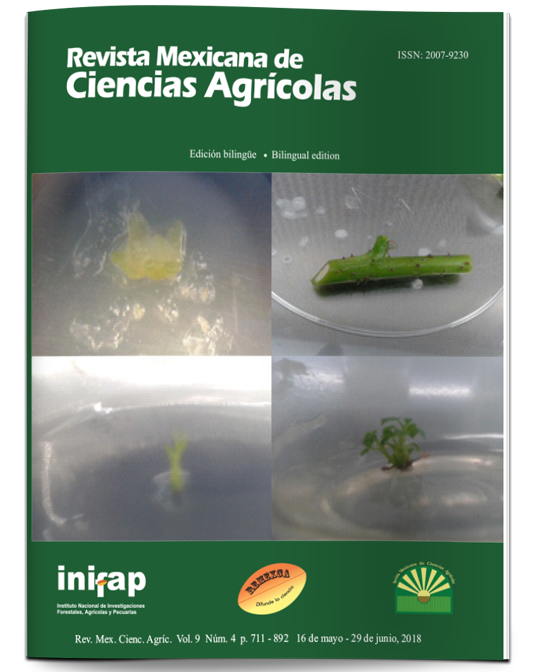P-Ca, AG4/7 and 6-BAP in the physiology and nutrition of tomato in the greenhouse
DOI:
https://doi.org/10.29312/remexca.v9i4.1392Keywords:
cytokinins, chlorophyll, prohexadione-calcium, gibberellins, lycopene, mineralsAbstract
The tomato is a crop of worldwide importance for its contribution in labor, economy and food quality. These characteristics require a continuous search for technologies that contribute to improving fruit yield and quality. In this study, the effect of bioregulators on foliar parameters, nutrient content, yield and fruit quality was evaluated in hybrid saladette tomato “Raptor-F1” at the UAAAN, Saltillo, Coahuila, during April-august 2015, under greenhouse conditions. When the plants showed floral primordia, a first foliar application was made with manual spray at the dew point of the treatments: control (water), P-Ca (50 mg L-1), AG4/7 (50 mg L-1), AG4/7 (100 mg L-1), 6-BAP (50 mg L-1), 6-BAP (100 mg L-1), AG4/7 (50 mg L-1)+6-BAP (50 mg L-1) and AG4/7 (100 mg L-1)+6-BAP (100 mg L-1) and 15 days later, a second application of the same doses was performed. A completely randomized statistical design with ten repetitions per treatment was established. The results were analyzed using the DMS test (p≤ 0.05). P-Ca and 6-BAP at 50 mg L-1 did not modify the foliar parameters and yield per plant; however, they increased the level of potassium in leaves and nitrogen and calcium in fruits. 6-BAP at 50 mg L-1 increased the fresh and dry matter, while when combined with gibberellin AG4/7 at 100 mg L-1 increased the vitamin C and lycopene content in fruits. It is concluded that the individual or combined concentrations of P-Ca, AG4/7 and 6-BAP, favor the quality of hybrid tomato “Raptor-F1” saladette in the greenhouse.
Downloads
Downloads
Published
How to Cite
Issue
Section
License
The authors who publish in Revista Mexicana de Ciencias Agrícolas accept the following conditions:
In accordance with copyright laws, Revista Mexicana de Ciencias Agrícolas recognizes and respects the authors’ moral right and ownership of property rights which will be transferred to the journal for dissemination in open access. Invariably, all the authors have to sign a letter of transfer of property rights and of originality of the article to Instituto Nacional de Investigaciones Forestales, Agrícolas y Pecuarias (INIFAP) [National Institute of Forestry, Agricultural and Livestock Research]. The author(s) must pay a fee for the reception of articles before proceeding to editorial review.
All the texts published by Revista Mexicana de Ciencias Agrícolas —with no exception— are distributed under a Creative Commons License Attribution-NonCommercial 4.0 International (CC BY-NC 4.0), which allows third parties to use the publication as long as the work’s authorship and its first publication in this journal are mentioned.
The author(s) can enter into independent and additional contractual agreements for the nonexclusive distribution of the version of the article published in Revista Mexicana de Ciencias Agrícolas (for example include it into an institutional repository or publish it in a book) as long as it is clearly and explicitly indicated that the work was published for the first time in Revista Mexicana de Ciencias Agrícolas.
For all the above, the authors shall send the Letter-transfer of Property Rights for the first publication duly filled in and signed by the author(s). This form must be sent as a PDF file to: revista_atm@yahoo.com.mx; cienciasagricola@inifap.gob.mx; remexca2017@gmail.
This work is licensed under a Creative Commons Attribution-Noncommercial 4.0 International license.



